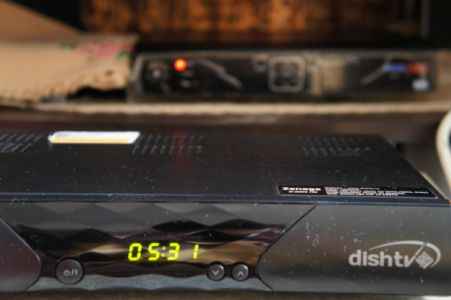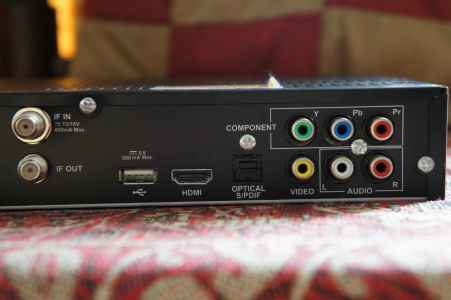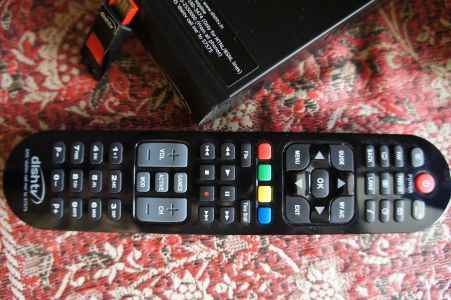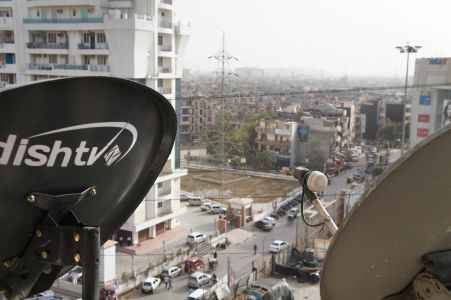For someone who already has an HD connection from Dishtv, it makes a lot of sense to upgrade – all you need to do is order a new remote. However, this isn’t a DVR in its truest sense – will only record one channel at a time and you cannot surf channels when a recording is on. Only meant for the occasional usage – have to record this program type of a scenario!
Look & Feel
For the sake of this review, we will be comparing the hardware of the Dish TruHD with Tata Sky HD and Airtel Digital TV HD, and not Tata Sky HD or any other DVR for that matter. The reason being that this service is essentially a later upgrade to an otherwise bog standard HD set top box, and critically, doesn’t have any internal storage as a DVR is supposed to have.
Sitting beside a Tata Sky HD set top box, the Dish TruHD box does have similar dimensions. While the Tata Sky box is slightly slimmer, there isn’t much to compare. The biggest different is that the Dishtv box has a display in the front that shows the channel number when in use, and the current time when in standby mode. Tata Sky’s HD box doesn’t have a display.
All connectivity ports – HDMI, composite video, component video, optical audio and the USB port are on the back.
TruHD’s and Airtel’s recorder remotes are slimmer when compared to the remote that Tata Sky offers with its recorder. However, we were surprised at how badly TruHD’s remote is laid out. The key placement isn’t well thought out. For example – the Menu key is in a separate cluster, while the Back key is in a cluster above that. Another example – the sound mute key is a million miles away from the volume keys. Ideally, related keys should be in the same bunch of buttons. Secondly, at most times when using the on-screen interface you actually use the Green coloured key to return, and not use the back button. This can be a bit confusing for most people at first. Back to the key placement, and we felt that the key size was also a tad small for some critical keys – back, previous channel and favorites. Despite using it for lengthy amounts of time, we still could not get used to the layout of this remote – had to look down and use it every single time. It is considerably easier with the remote that Airtel offers, even though it suffers from its own set of problems – flat keys and not enough gaps between them. Tata Sky’s remote is the easiest to get your fingers to remember, partly helped by the slight outward bulge on both sides in the top half.
In terms of build quality, we can’t hold anything against the Dishtv TruHD set top box. It doesn’t have any rough edges, and feels well put together. The display at the front does add a lot of value, something you realize when you actually get to use it – knowing the current channel number without having to pick up the remote and using the menu.
Visit next page to read Dish TruHD Plus’ features and performance
Features & Performance
The Dishtv technical team were quite competent, and took them about 20 minutes to drill the grooves in the balcony, install the dish and lay a cable of about 15 metres to the TV. The signal meter is used to measure the signal strength from each transponder of the satellites being used. The dish has to be aligned at an exact angle. At the first start, the software is downloaded on the set top box. That process took about 5 minutes. Activation was almost instantaneous, once the engineer called the back-end team informing about the completion of the installation.
To test, we used both DTH services on the same television – a Sony Bravia 40EX500 LCD television with the exact same picture settings on both sources. The HDMI cables provided were the default ones that Tata Sky and Dishtv provide. The television was connected with a Denon AVR1311 receiver with a 5.1 channel speaker system.
 |
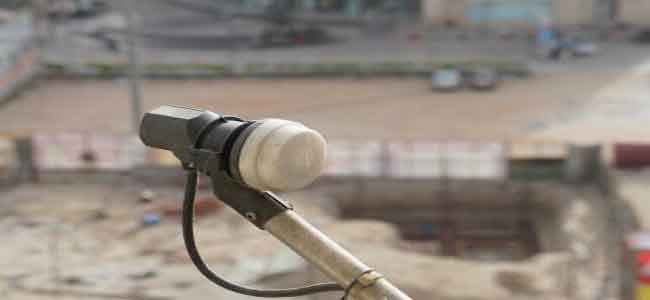 |
You will notice that the Low Noise Block (LNB) down converter used by Dishtv is bigger than the one on Tata Sky. That is because this is a dual LNB, capable of receiving signals from two different satellites. Dishtv is using the transponders on NSS6 and the Asiasat 5 satellites for the channels. To help understand this better, every individual transponder is like hard drive capacity. You can only fill up the hard drive with so many movies. A satellite consists of a bunch of transponders.
Dishtv currently uses two different satellites to beam channels to the consumers. Considering the fact that every satellite has limited transponder space, this move has helped them offer more channels than the rivals.
The Zenega set top box from Dishtv has 1 USB port at the back, while the HD boxes from Airtel Digital TV HD and Tata Sky HD have two. Having said that, both Tata Sky and Airtel haven’t launched recorder services on their HD boxes, so we don’t really know how the two USB ports will actually work. Dish TruHD box has optical audio out as an option, in case you are connecting it to a receiver, while Tata Sky and Airtel’s hardware only offers co-axial audio outputs.
We believe that the most critical thing for any DTH is the user interface it offers. Since this is the element that is visible most of the time, in totality or even in certain parts. Dishtv’s interface has improved a lot over the years. Critically, it doesn’t have any lag, for the most part. It is still a little clunky, when compared side by side with that of the rivals. Dull colour combinations take away some of the visual punch – something that you immediately notice when compared with the UI offered by Tata Sky and Airtel. In certain places, the Dishtv’s UI looks hurriedly put together. The banner that shows up when changing a channel is a prime example of what we are talking about. The design is clunky, and setting a reminder, scheduling a recording or even setting/removing a channel as favorite is quite a task in itself. The screenshots below will show the comparison between Dishtv and Tata Sky.
Quite surprisingly, Dishtv offers a bit more freedom when it comes to audio and video settings than what Tata Sky does. In the TruHD box, you can set it up to a resolution of 1920x1080i 60Hz, whereas in Tata Sky, you are allowed to only select the resolution – 720i or 1080i but not the refresh rate, which is fixed at 50Hz. When we set TruHD to 1920x1080i 60Hz, there was a considerable judder during fast moving scenes in sports and movies. Lowering that to 50Hz with the same resolution solved the issue. For audio, you can tweak the 5.1 channel settings, intelligent volume control and virtual surround. Activating or disabling the 5.1 channel setting makes a lot of difference, but we didn’t notice any change when the volume control was on or off. Virtual surround tends to make the dialogue a bit muffled, and is best set at off.
Dishtv claims to have 40 HD channels (which they call “services”). However, to prick the bubble here, there are only 12 of these are real HD channels. The rest are basically SD channels with artificially boosted resolution. The term for that is upscale, but it doesn’t make SD content as HD in any way. Plus, you can clearly see the difference between original HD channels and the upscale ones anyway. The primary difference being the 4:3 display ratio that is stretched to fit the HDTVs that display in the 16:9 ratio. With original HD content, the recording itself is in 16:9, thus making the objects look real, and not artificially fattened!
The picture quality of HD channels on Dishtv is very similar to that on Tata Sky. While there aren’t many common HD channels on the two platforms, the likes of Discovery HD and National Geographic HD looked similarly brilliant – vivid and crisp. In terms of audio, Dishtv has a slight advantage on both these channels. While it isn’t confirmed, Tata Sky seems to be deploying some Digital Range Compression on the audio feeds of certain HD channels, which results in an un-authentic HD audio experience. You will notice this if you are using a 5.1 channel receiver. To put it simply, the vocals should ideally come from the centre channel, and the surround speakers should only get the frequencies meant for surround. However, we notice that on Tata Sky’s HD channels, vocals tend to fade in and fade out on the rear speakers as well. No such issues with Dishtv TruHD.
Visit next page to continue reading Dish TruHD Plus’ features and performance; also check out our verdict…
With regards to SD channels however, Tata Sky seems to be a lot better. We say this because on Dishtv, certain SD channels (again, notice when we say certain and not all) suffer from a bit of noise. We particularly noticed this problem on Star World, in straight comparison with Tata Sky. However, the benefit of doubt can be given, since any reduction in the signal for that individual transponder on the satellite does affect quality a bit, and is usually a temporary glitch.
The recording feature is an add-on for existing customers. What a recent software update did was activate the USB port on the set top box, allowing for recording. Existing customers can activate this service and order the recorder remote. The charge for this is Rs 300, and is deducted from the mount you may have in the dishtv account. The recording feature works well. You can start a recording manually, or even schedule recordings for a later time. This can be set from the program guide that shows the schedule for the next week. However, there are certain limitations when compared to a DVR. First, you can only record one program at a time, and not two. Secondly, you cant set one recording and browse the channels simultaneously. Third, when the recording is on, you cannot change the channel, else the recording will stop. All this is a limitation of the fact that unlike a DVR, this set top box only takes in one wire from the dish. With a DVR, there are two cables inputting signal from the dish, which allows for simultaneous multi-tasking. But then again, it is a value addition to the entire experience. There is a 4GB USB drive that comes as a part of the package. You can use up to 2TB of external storage to record, but be aware that the particular drive once deployed here will not be used anywhere else during that time. That’s because the drive is formatted in a proprietary format (to prevent piracy issues from cropping up) that can only be read by this STB.
Our Take
The Dishtv TruHD service is a neat upgrade for an existing HD service user. However, it is meant only for the occasional recording, owing to the limitations we have mentioned earlier. We suggest you consider a full-fledged DVR from Dishtv or even Tata Sky or Airtel if you want anything more, but be aware that it will cost considerably more up-front. Also, do check the channel packages before buying, and save the possible heartache at a later date!
Price: Rs 2690 ( 1 month free HD Royale or HD Premiere or HD World pack)
Contact: Dishtv India ltd
Phone: 0120-2550000
Email: customercare@dishtv.in

